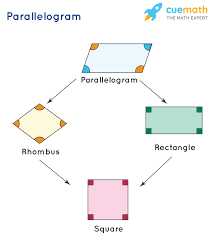Properties of parallelogram, rhombus and kite - JSS2 Mathematics Lesson Note
1. Parallelogram
Properties:
Opposite Sides are Parallel and Equal: Both pairs of opposite sides are parallel and of equal length.
Opposite Angles are Equal: Both pairs of opposite angles are equal.
Consecutive Angles are Supplementary: Each pair of consecutive angles adds up to 180 degrees.
Diagonals Bisect Each Other: The diagonals of a parallelogram bisect each other.
Example:
Consider a parallelogram ABCD:
If AB = 6 cm and AD = 4 cm, then CD = 6 cm and BC = 4 cm.
If ∠A = 70°, then ∠C = 70° and ∠B = 110° and ∠D = 110°.
The diagonals AC and BD intersect at point O, and AO = OC, BO = OD.
2. Rhombus
A rhombus is a special type of parallelogram where all sides have equal length.
Properties:
All Sides are Equal: All four sides are of equal length.
Opposite Angles are Equal: Opposite angles are equal.
Diagonals are Perpendicular: The diagonals bisect each other at right angles (90 degrees).
Diagonals Bisect Angles: Each diagonal bisects a pair of opposite angles.
Example:
Consider a rhombus EFGH:
If EF = 5 cm, then FG = 5 cm, GH = 5 cm, and HE = 5 cm.
If ∠E = 60°, then ∠G = 60° and ∠F = 120° and ∠H = 120°.
The diagonals EG and FH intersect at point O at right angles, making ∠EOF = ∠GOH = 90°.
The diagonals also bisect the angles: ∠EOF = 30°, ∠FOE = 60°, etc.

Source:(Cuemath.com)
3. Kite
A kite has two pairs of adjacent sides that are equal and one pair of opposite angles that are equal.
Properties:
Two Pairs of Adjacent Sides are Equal: The kite has two pairs of adjacent sides of equal length.
One Pair of Opposite Angles are Equal: The angles between the unequal sides are equal.
Diagonals are Perpendicular: The diagonals intersect at right angles.
One Diagonal Bisects the Other: One of the diagonals bisects the other.
Example:
Consider a kite IJKL:
If IJ = IK = 7 cm and JL = KL = 5 cm.
If ∠J = ∠K = 60°, then ∠I and ∠L are not necessarily equal.
The diagonals IL and JK intersect at right angles.
Diagonal IL bisects diagonal JK.